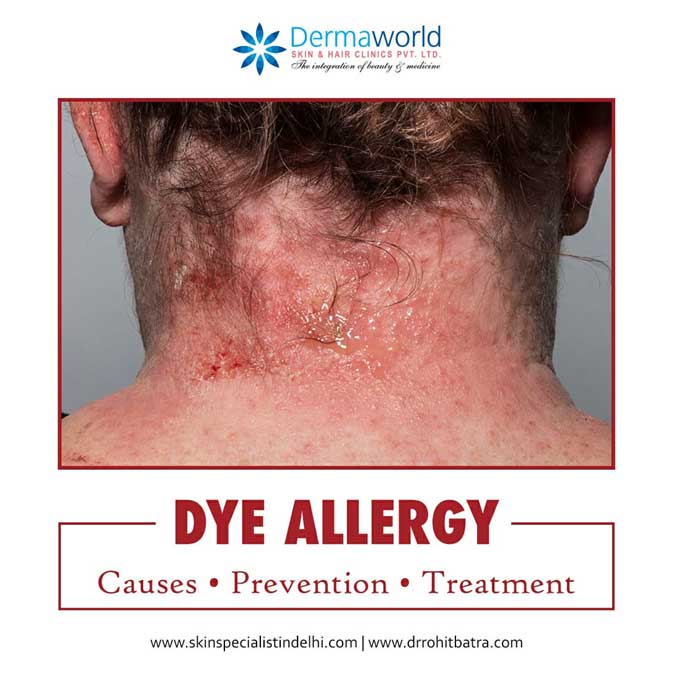Learn All About Allergy from Hair Colour/Hair Dye Allergy Treatment, Causes & Prevention
An allergic reaction to hair dye is due to a reaction to paraphenylenediamine also known as PPD which is a common ingredient in hair dyes. DermaWorld explains why Hair Colour/Hair Dye causes allergy, how you can it be prevented & what is the hair dye allergy treatment options in Delhi.
Causes of Hair Colour/Hair Dye Allergy
Causes
Paraphenylenediamine (PPD), the chemical found in most hair dyes, is the usual suspect for allergic reactions. Paraphenylenediamine or PPD, is found in most commercially produced hair dyes, as is peroxide. When the two react, the PPD becomes partially oxidized and colored; in this state, it can lead to an allergic reaction.
- When you are left with an irritated scalp after using hair dye, it’s likely an allergic reaction, sometimes called contact dermatitis, on your skin.
- This reaction is especially prevalent when using at-home dyes that tend to sit on the scalp, rather than being applied to just the strands in a more professional manner.
- Most chemical hair dyes contain both paraphenylenediamine and ammonia, known for irritating the skin. When the chemicals come in contact with your skin, they essentially burn the surface, resulting in an itchy rash.
Signs and Symptoms of a Hair Dye Reaction
Signs and Symptoms
Reactions to PPD can range from mild irritation in the scalp to an allergic reaction that can potentially trigger serious symptoms throughout the body.
Mild Irritation
- If you’re mildly irritated by PPD, you may notice that your neck, forehead, scalp, ears or eyelids will become inflamed & irritated after using hair colour or dye.
- The skin getting exposed to the PPD may show symptoms like redness, blistered, swollen, thickened, dry and cracked. You may feel a sensations like stinging or burning.
- Mild to moderate contact reactions such as erythema, oozing, and ulceration typically at the scalp margin, and on the ears and neck are common as a result of direct contact.
- Symptoms will usually appear within 48 hours, although strong irritants may cause your skin to react immediately.
Allergic Reaction
- If you’re allergic to PPD, your scalp and face may feel itchy and start to swell.
- PPD may also trigger symptoms throughout your body, such as itching, a nettle rash and generally feeling ill.
- These symptoms may not develop until hours, or even days, later.
A severe allergic reaction that develops within few minutes after applying hair dye is called anaphylaxis, or “anaphylactic shock”.
Signs of anaphylaxis include:
- Itchy skin or a raised, red skin rash
- Swollen lips, eyes, hands and feet – the swelling on eyelids could be like, you won’t be able to open your eyes
- Feeling lightheaded or faint
- Swelling of the throat, mouth or tongue, which may cause trouble in swallowing & breathing
- Abdominal pain, nausea and vomiting
- Unconsciousness
How to prevent hair dye allergy to happen?
Prevention
How to avoid a reaction to hair dye.
Patch Test
Always carry out a patch test before using a permanent or semi-permanent hair dye, even if you are using your regular brand.
This usually involves dabbing a small amount of the dye solution behind your ear or on your inner elbow and leaving it to dry. Follow the instructions that come with the dye.
If you develop any irritation or feel unwell after the patch test, do not use the product.
Other Precautions
If you do not develop any reaction from the patch test, you can continue to use the dye, but make sure you:
- Do not leave it on for longer than the recommended time
- Wear gloves when applying the dye
- Rinse your hair thoroughly afterwards
- Carefully follow the instructions included
Avoiding PPD
If you develop a reaction to hair dye, even just a mild one, you should stop using products containing PPD altogether, as there’s a risk you could develop a more severe reaction in the future.
Try switching to a safer alternative, such as a non-permanent, PPD-free hair dye – but be aware that it’s still possible to develop a reaction to this.
Henna – a natural product that’s been used in India for hundreds of years and gives a reddish colour to the hair. Be sure you are buying pure henna, and avoid a newer product called black henna, which may have added PPD.
Treatment for Hair Colour/Hair Dye Allergy
Treatment
The hair dye allergy may occur after years of no problem. Almost all hair dyes available in Indian markets (even ayurvedic ones) are paraphenylene diamine (PPD) containing hair dyes. They may colour the hair black, brown, red, or any other. Once you develop allergy to this dye, changing brand may not help.
Relieving Mild Symptoms
Wash your hair and scalp thoroughly with mild shampoo to remove any excess dye.
Try gently applying an emollient (moisturising treatment) such as aqueous cream to the affected skin.
Steroid Cream
- If your skin is very red, sore and inflamed, you may need to try a steroid cream. One can buy mild steroid cream over the counter (after speaking to your GP for advice).
- Weaker versions such as hydrocortisone 1% are available over the counter but more potent formulations require a prescription and would be used in more significant reactions.
- Steroid shampoos may also be prescribed by your dermatologist.
- Oral antihistamines for controlling the allergic reaction.



